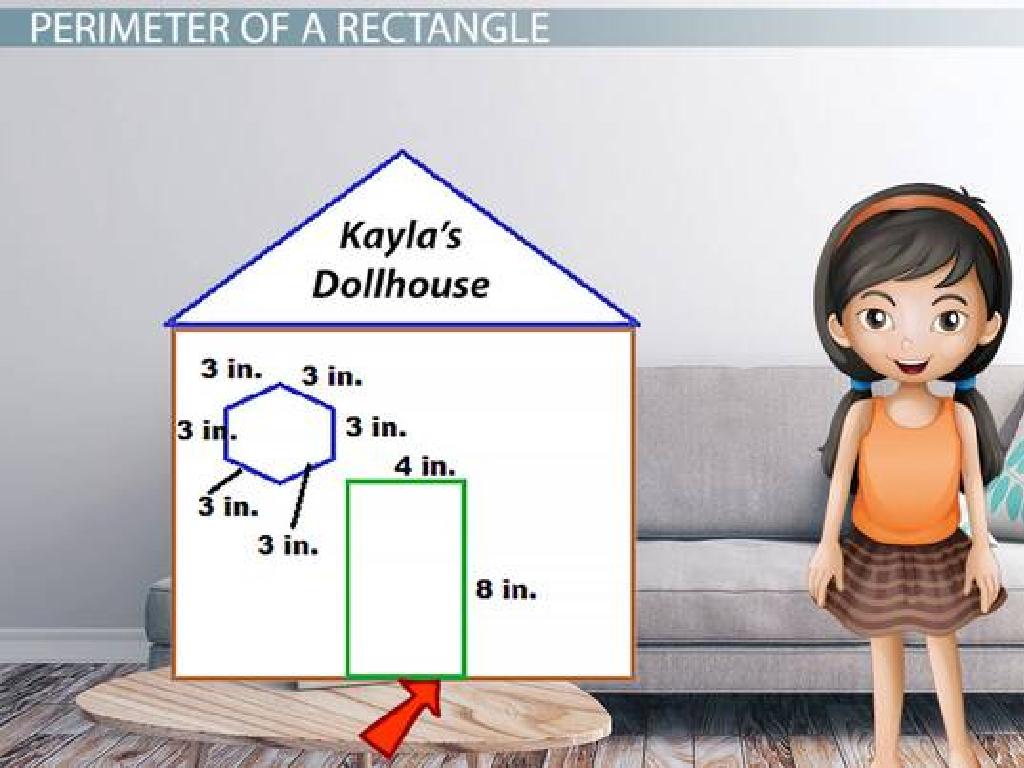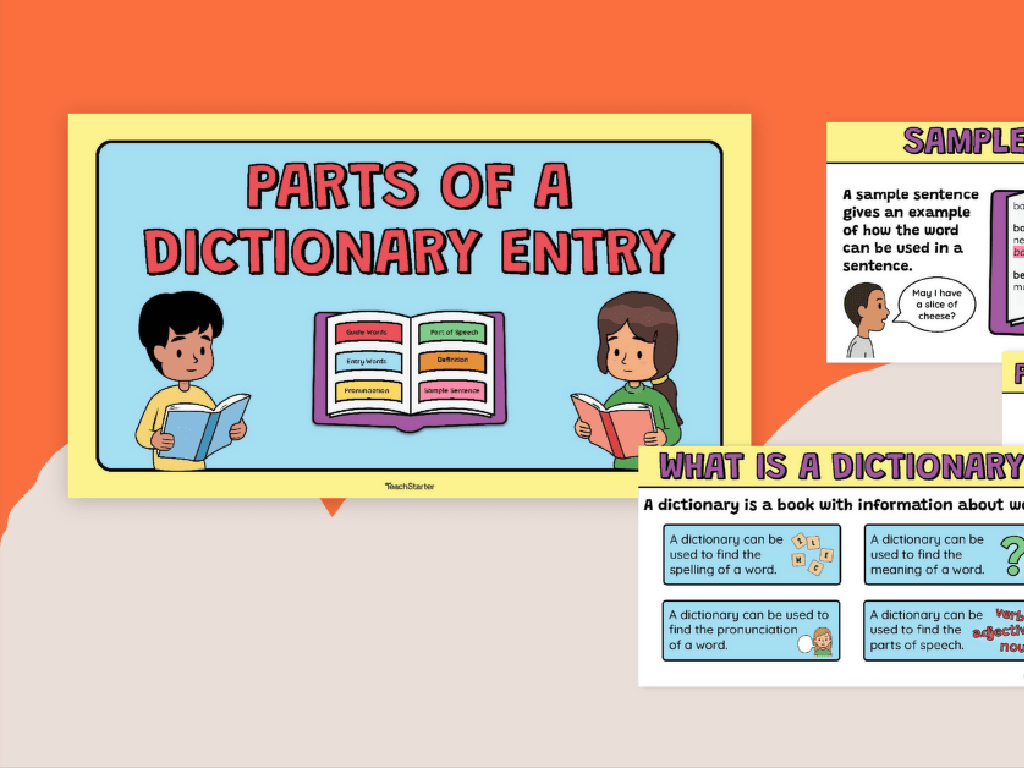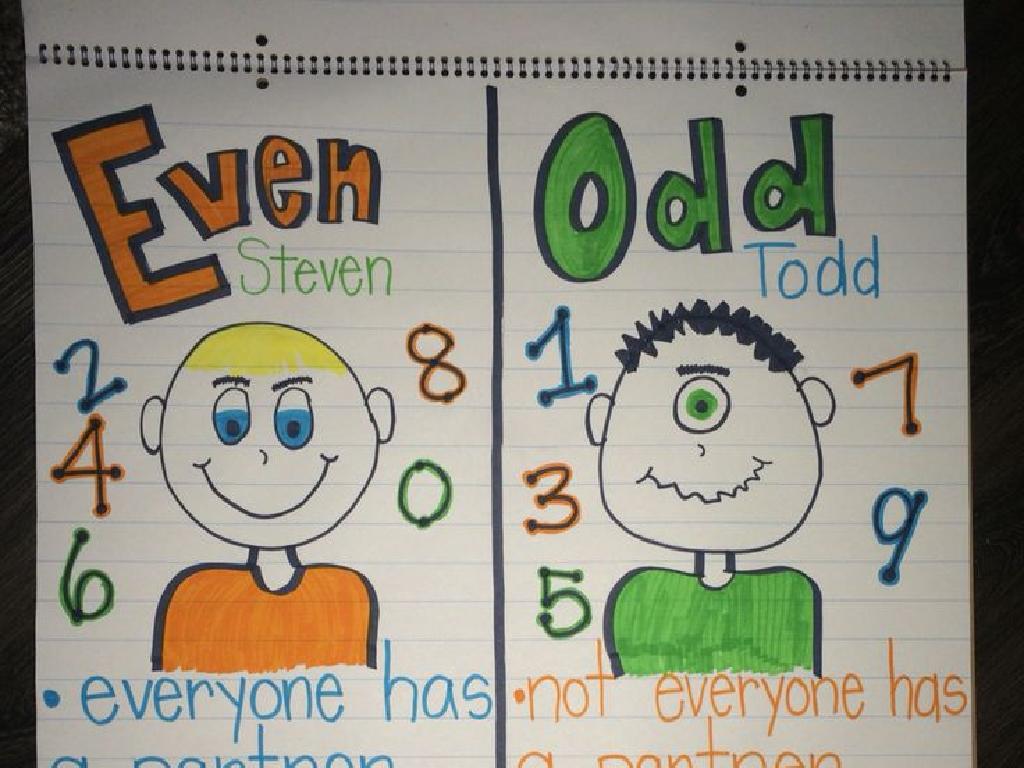Add, Subtract, Multiply, And Divide Fractions And Mixed Numbers
Subject: Math
Grade: Fifth grade
Topic: Mixed Operations: Fractions
Please LOG IN to download the presentation. Access is available to registered users only.
View More Content
Mixed Operations with Fractions
– Recap: What are fractions?
– Fractions represent parts of a whole.
– Today’s goal: Mastering operations
– Learn to add, subtract, multiply, divide fractions.
– Real-life applications of fractions
– Cooking, budgeting, measuring – fractions are key.
– Practice makes perfect!
|
Begin with a brief review of fractions to ensure students recall the basics of what fractions represent. Today’s objective is to build on that understanding by learning how to perform all four operations with fractions. Emphasize the importance of these skills in everyday life, such as in cooking (halving a recipe), budgeting (dividing an allowance), and measuring materials for a project. Encourage students to practice these skills with a variety of problems to gain confidence and proficiency. Provide examples and have students work through problems in groups to facilitate peer learning.
Adding Fractions: A Step-by-Step Guide
– Add fractions with like denominators
– Simply add the numerators when denominators are the same
– Add fractions with unlike denominators
– Convert to have the same denominators before adding
– Find the Least Common Denominator (LCD)
– LCD is the smallest number that both denominators can divide into
– Use LCD to add fractions
– Add the converted fractions using the new same denominator
|
This slide introduces students to the concept of adding fractions, both with like and unlike denominators. Start by explaining that when the denominators are the same, addition is straightforward just add the numerators. When the denominators are different, teach students to find the LCD, which is the smallest common multiple of the denominators. Once the LCD is found, convert the fractions so they have the same denominator and then add them. Use examples to illustrate each step, such as 1/4 + 1/4 for like denominators and 1/3 + 1/4 for unlike denominators, showing the process of finding the LCD (12) and converting the fractions to 4/12 + 3/12 before adding them to get 7/12.
Subtracting Fractions
– Subtract with same denominators
– Simply subtract the numerators and keep the denominator the same.
– Find difference with different denominators
– Find a common denominator, then subtract the numerators.
– Understand borrowing in fractions
– Borrowing means taking ‘1’ from the whole number in mixed fractions.
– Practice subtraction problems
|
This slide focuses on teaching students how to subtract fractions. Start by explaining that when the denominators are the same, they only need to subtract the numerators. For fractions with different denominators, guide them to find a common denominator before subtracting. Introduce the concept of borrowing in fractions, which is similar to borrowing in whole number subtraction but involves taking ‘1’ from the whole number part of a mixed number and converting it into a fraction. Provide several examples for each case and encourage students to solve subtraction problems as practice. Make sure to demonstrate each step clearly and check for understanding before moving on to the next concept.
Multiplying Fractions
– Multiplication as repeated addition
– Just like adding the same number over and over!
– Simplify with cross-canceling
– Reduce fractions first to make multiplying easier
– Convert mixed numbers to multiply
– Change mixed numbers to improper fractions before multiplying
– Practice with examples
|
When teaching multiplication of fractions, start by relating it to repeated addition, which they are already familiar with. Emphasize that multiplying two fractions is just like adding one fraction to itself multiple times. Introduce cross-canceling as a method to simplify fractions before multiplying, which makes the calculation easier. Demonstrate how to convert mixed numbers to improper fractions, as this is a necessary step before multiplication. Provide plenty of examples for the students to practice these concepts. Encourage them to work through the problems step-by-step and to always simplify their answers.
Dividing Fractions and Mixed Numbers
– Divide fractions using multiplication
– Invert the divisor and multiply to find the quotient.
– Learn about reciprocals
– A reciprocal is 1 divided by the number, e.g., reciprocal of 2/3 is 3/2.
– Step-by-step mixed numbers division
– Convert to improper fractions, find reciprocals, multiply, and simplify.
– Practice with examples
|
This slide introduces students to the concept of dividing fractions by inverting and multiplying. Explain that the reciprocal of a number is what you multiply it by to get 1. For dividing mixed numbers, guide students through the process of converting mixed numbers to improper fractions, finding the reciprocal of the divisor, and then multiplying. Emphasize the importance of simplifying the final answer. Provide practice problems for students to apply these steps, such as dividing 2 1/3 by 3/4, and encourage them to work through the problems as a class or in groups.
Mixed Operations with Fractions
– Understand PEMDAS with fractions
– PEMDAS: Parentheses, Exponents, Multiplication, Division, Addition, Subtraction
– Solve mixed operation problems
– Combine different operations in one problem, step by step
– Example: Adding & subtracting fractions
– Add 1/4 + 1/2, then subtract 1/8 from the sum
– Example: Multiplying & dividing fractions
– Multiply 2/3 by 3/4, then divide the product by 1/2
|
This slide introduces students to the concept of applying the order of operations, known as PEMDAS, to problems involving fractions. Start by explaining each component of PEMDAS and how it applies to fractions. Then, demonstrate how to solve problems that include a mix of addition, subtraction, multiplication, and division of fractions. Use clear examples to show step-by-step solutions. For instance, show how to add two fractions with different denominators, then subtract a fraction from the result. Similarly, demonstrate how to multiply two fractions and then divide by another fraction. Encourage students to follow the order of operations carefully and check their work at each step. Provide additional practice problems for students to solve independently.
Class Activity: Fraction Operations Relay
– Form teams for a relay challenge
– Each team solves a fraction operation step
– One team member adds, another subtracts, etc.
– Work together to complete the problem
– Collaboration is key to find the solution
– Race to be the first team with correct answer
|
This activity is designed to promote teamwork and reinforce the concept of mixed operations with fractions. Divide the class into small groups, ensuring a mix of abilities in each team. Provide each team with a multi-step problem involving addition, subtraction, multiplication, and division of fractions and mixed numbers. Each member of the team will be responsible for one operation and must pass the problem to the next member after completing their step. The first team to arrive at the correct final answer wins. Possible variations of the activity could include a relay race where students physically move to a station to complete their operation, or a ‘telephone’ game where each step is whispered to the next team member to add an element of communication skills. Ensure that all students are engaged and understand their operation before beginning the activity.
Wrapping Up: Fractions Mastery
– Recap of fraction operations
– Practice makes perfect
Regular practice is key to understanding fractions.
– Homework: Mixed Fractions Worksheet
Complete the worksheet to reinforce today’s lesson.
– Keep practicing at home!
|
As we conclude today’s lesson on mixed operations with fractions, it’s important to emphasize the role of consistent practice in mastering these concepts. The homework assignment is a practice worksheet that covers addition, subtraction, multiplication, and division of fractions and mixed numbers. This will help students solidify their understanding and prepare them for more advanced math topics. Encourage students to attempt the worksheet independently, but remind them to reach out for help if they encounter difficulties. In the next class, we’ll review the homework answers and clarify any misconceptions. Remember to praise their efforts and progress in learning these fundamental math skills.






